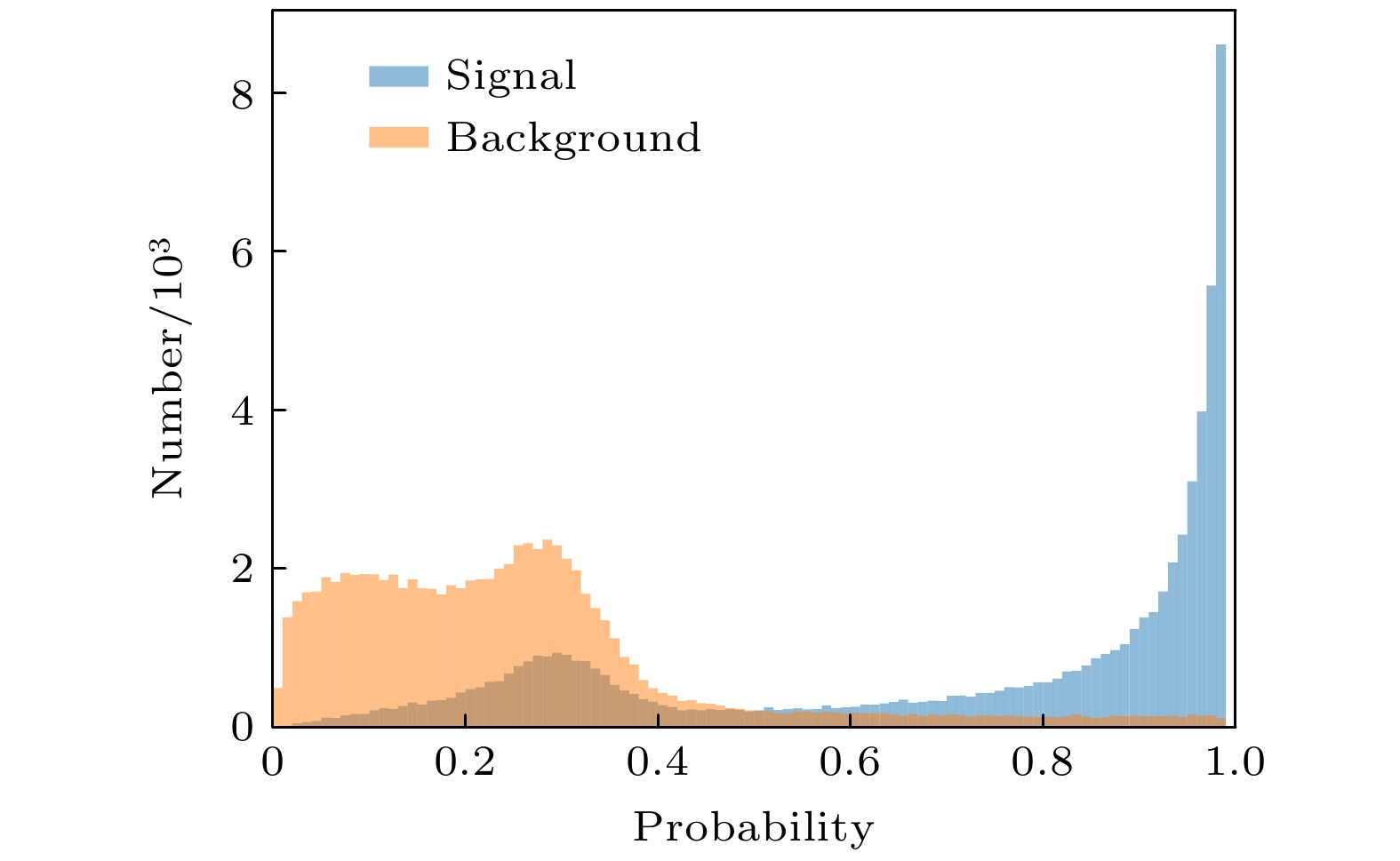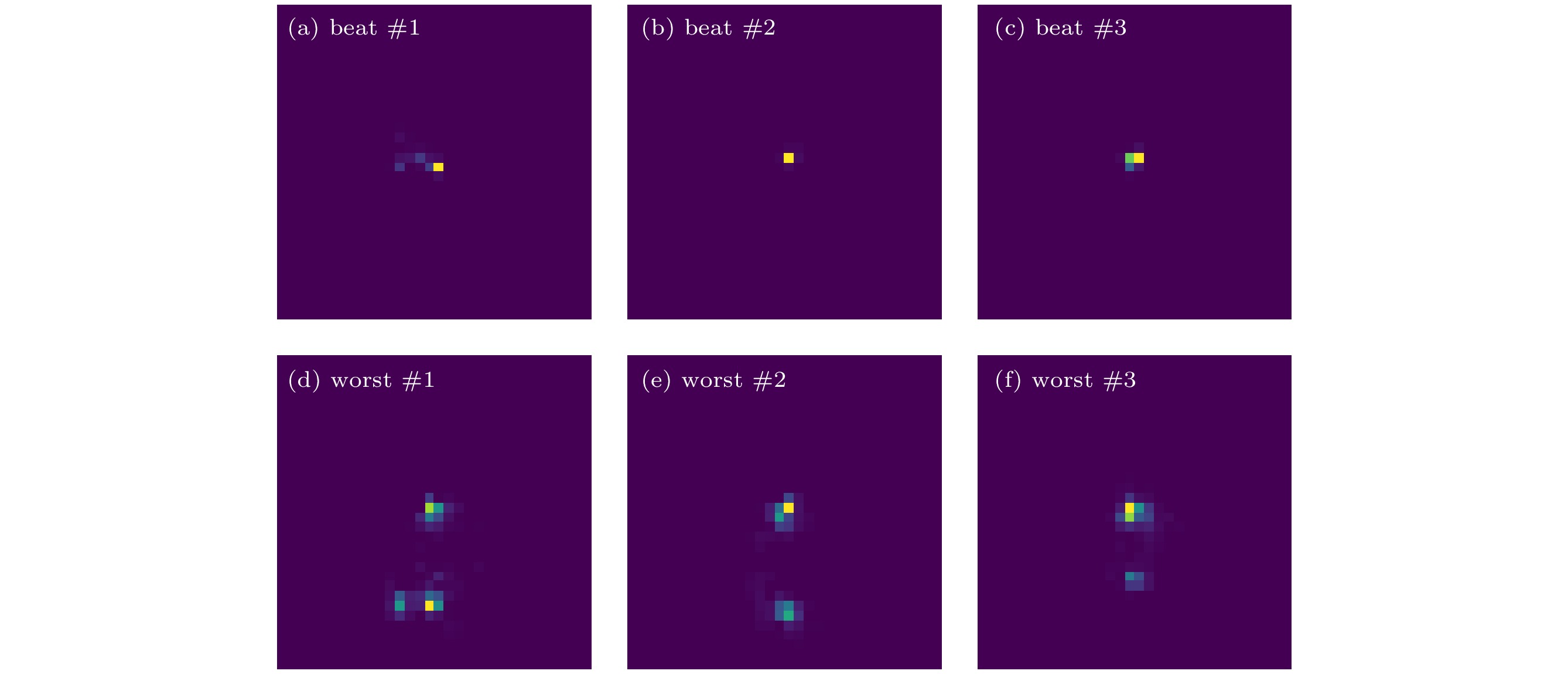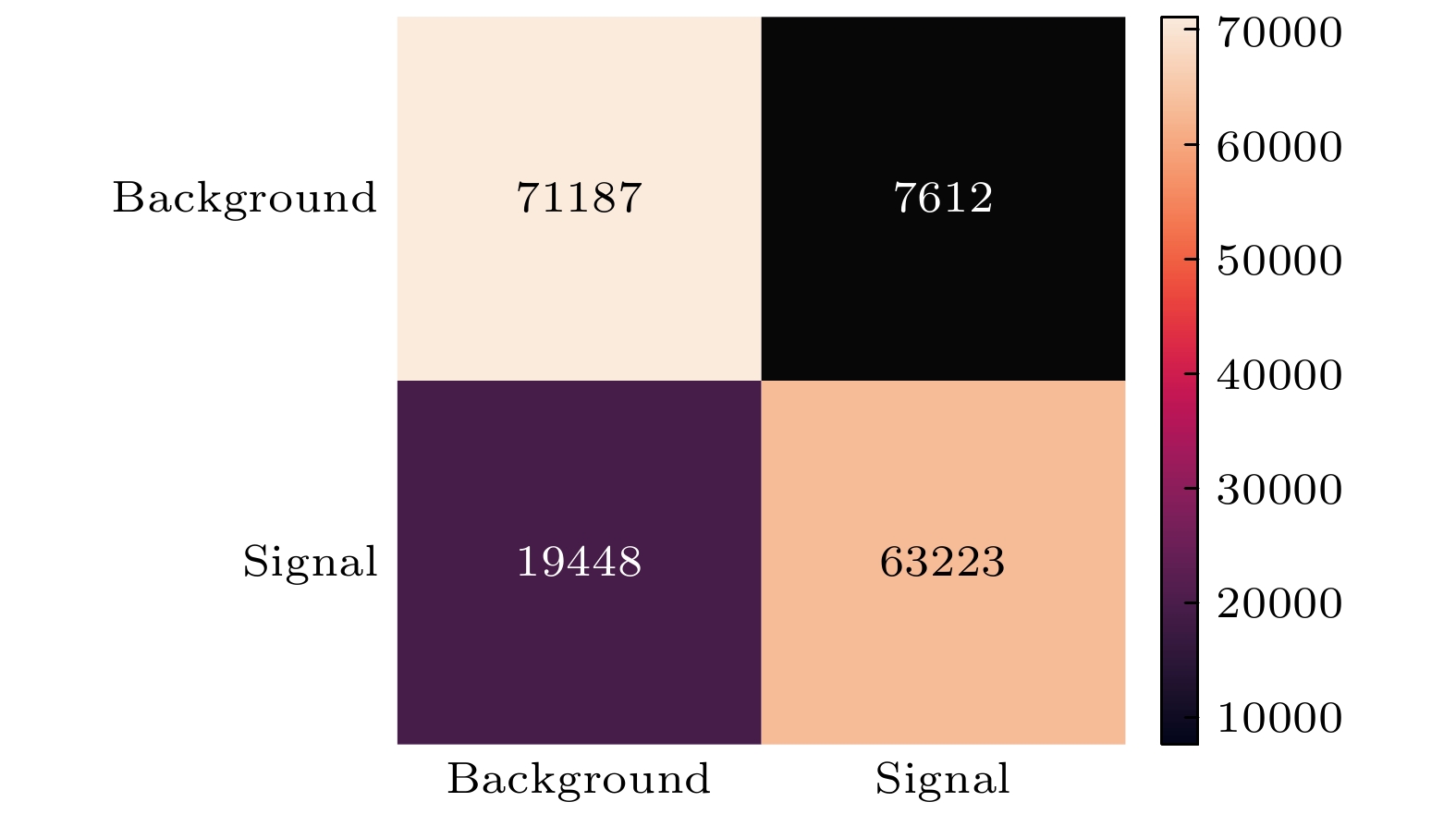-
高能物理中喷注识别任务是从背景中识别出感兴趣的特定信号, 这些信号对于在大型强子对撞机上发现新的粒子, 或者新的过程都有着非常重要的意义. 量能器中产生的能量沉积可以看做是对喷注的一种拍照, 分析这样产生的数据在机器学习领域中属于一个典型的视觉识别任务. 基于喷注图片, 本文探索了利用卷积神经网络(convolutional neural networks, CNNs)识别量子色动力学背景下的Z玻色子喷注, 并与传统的增强决策树(boosted decision trees, BDTs)方法进行了对比. 在本文利用的输入前提下, 三种相关的性能参数表明, CNN比BDT带来了约1.5倍的效果提升. 除此之外, 通过最优与最差的喷注图与混淆矩阵, 说明了CNN通过训练学习到的内容与整体识别能力.The jet tagging task in high-energy physics is to distinguish signals of interest from the background, which is of great importance for the discovery of new particles, or new processes, at the large hadron collider. The energy deposition generated in the calorimeter can be seen as a kind of picture. Based on this notion, tagging jets initiated by different processes becomes a classic image classification task in the computer vision field. We use jet images as the input built on high dimensional low-level information, energy-momentum four-vectors, to explore the potential of convolutional neural networks (CNNs). Four models of different depths are designed to make the best underlying useful features of jet images. Traditional multivariable method, boosted decision tree (BDT), is used as a baseline to determine the performance of networks. We introduce four observable quantities into BDTs: the mass, transverse momenta of fat jets, the distance between the leading and subleading jets, and N-subjettiness. Different tree numbers are adopted to build three kinds of BDTs, which is intended to have variable classifying abilities. After training and testing, the results show that the CNN 3 is the neatest and most efficient network under the design of stacking convolutional layers. Deepening the model could improve the performance to a certain extent but it is unable to work all the time. The performances of all BDTs are almost the same, which is possibly due to a small number of input observable types. The performance metrics show that the CNNs outperform the BDTs: the background rejection efficiency increases up to 150% at 50% signal efficiency. Besides, after inspecting the best and the worst samples, we conclude the characteristics of jets initiated by different processes: jets obtained by Z boson decays tend to concentrate in the center of jet images or have a clear differentiable substructure; the substructures of jets from general quantum chromodynamics processes have more random forms and not only just have two subjets. As the final step, the confusion matrix of the CNN 3 indicate that it comes to be kind of conservative. Exploring the way of keeping the balance between conservative and radical is our goal in the future work.
-
Keywords:
- decays of Z bosons /
- quarks /
- gluons /
- neural network
[1] Kogler R, Nachman B, Schmidt A, Asquith L, Winkels E, Campanelli M, Delitzsch C, Harris P, Hinzmann A, Kar D, McLean C, Pilot J, Takahashi Y, Tran N, Vernieri C, Vos M 2019 Rev. Mod. Phys. 91 045003
 Google Scholar
Google Scholar
[2] Kasieczka G, Plehn T, Butter A, Cranmer K, Debnath D, Dillon B M, Fairbairn M, Faroughy D A, Fedorko W, Gay C, Gouskos L, Kamenik J F, Komiske P, Leiss S, Lister A, Macaluso S, Metodiev E, Moore L, Nachman B, Nordström K, Pearkes J, Qu H, Rath Y, Rieger M, Shih D, Thompson J, Varma S 2019 SciPost Phys. 7 014
 Google Scholar
Google Scholar
[3] Larkoski A J, Moult I, Nachman B 2020 Phys. Rep. 841 1
 Google Scholar
Google Scholar
[4] 来志, 郭亮, 李小珍, 党文佳 2013 物理学报 62 184207
 Google Scholar
Google Scholar
Lai Z, Guo L, Li X Z, Dang W J 2013 Acta Phys. Sin. 62 184207
 Google Scholar
Google Scholar
[5] 杨自欣, 高章然, 孙晓帆, 蔡宏灵, 张凤鸣, 吴小山 2019 物理学报 68 210502
 Google Scholar
Google Scholar
Yang Z X, Gao Z R, Sun X F, Cai H L, Zhang F M, Wu X S 2019 Acta Phys. Sin. 68 210502
 Google Scholar
Google Scholar
[6] 徐启伟, 王佩佩, 曾镇佳, 黄泽斌, 周新星, 刘俊敏, 李瑛, 陈书青, 范滇元 2020 物理学报 69 014209
 Google Scholar
Google Scholar
Xu Q W, Wang P P, Zeng Z J, Huang Z B, Zhou X X, Liu J M, Li Y, Chen S Q, Fan D Y 2020 Acta Phys. Sin. 69 014209
 Google Scholar
Google Scholar
[7] Cogan J, Kagan M, Strauss E, Schwarztman A 2015 J. High Energy Phys. 2015 118
 Google Scholar
Google Scholar
[8] Almeida L G, Backović M, Cliche M, Lee S J, Perelstein M 2015 J. High Energy Phys. 2015 86
 Google Scholar
Google Scholar
[9] Chen Y C J, Chiang C W, Cottin G, Shih D 2020 Phys. Rev. D 101 053001
 Google Scholar
Google Scholar
[10] Qu H, Gouskos L 2020 Phys. Rev. D 101 056019
 Google Scholar
Google Scholar
[11] Diefenbacher S, Frost H, Kasieczka G, Plehn T, Thompson J 2020 SciPost Phys. 8 023
 Google Scholar
Google Scholar
[12] Fraser K, Schwartz M D 2018 J. High Energy Phys. 2018 93
 Google Scholar
Google Scholar
[13] Macaluso S, Shih D 2018 J. High Energy Phys. 2018 121
 Google Scholar
Google Scholar
[14] Lin J, Freytsis M, Moult I, Nachman B 2018 J. High Energy Phys. 2018 101
 Google Scholar
Google Scholar
[15] Komiske P T, Metodiev E M, Schwartz M D 2017 J. High Energy Phys. 2017 110
 Google Scholar
Google Scholar
[16] Kasieczka G, Plehn T, Russell M, Schell T 2017 J. High Energy Phys. 2017 6
 Google Scholar
Google Scholar
[17] Baldi P, Bauer K, Eng C, Sadowski P, Whiteson D 2016 Phys. Rev. D 93 094034
 Google Scholar
Google Scholar
[18] Oliveira L, Kagan M, Mackey L, Nachman B, Schwartzman A 2016 J. High Energy Phys. 2016 69
 Google Scholar
Google Scholar
[19] Guest D, Collado J, Baldi P, Hsu S C, Urban G, Whiteson D 2016 Phys. Rev. D 94 112002
 Google Scholar
Google Scholar
[20] Butter A, Kasieczka G, Plehn T, Russell M 2018 SciPost Phys. 5 028
 Google Scholar
Google Scholar
[21] Kasieczka G, Kiefer N, Plehn T, Thompson J 2019 SciPost Phys. 6 069
 Google Scholar
Google Scholar
[22] Erdmann M, Geiser E, Rath Y, Rieger M 2019 J. Instrum. 14 P06006
 Google Scholar
Google Scholar
[23] Abdughani M, Ren J, Wu L, Yang J M 2019 J. High Energy Phys. 2019 55
 Google Scholar
Google Scholar
[24] Komiske P T, Metodiev E M, Thaler J 2019 J. High Energy Phys. 2019 121
 Google Scholar
Google Scholar
[25] Sjöstrand T, Ask S, Christiansen J R, Corke R, Desai N, Ilten P, Mrenna S, Prestel S, Rasmussen C O, Skands P Z 2015 Comput. Phys. Commun. 191 159
 Google Scholar
Google Scholar
[26] Cacciari M, Salam G P, Soyez G 2012 Eur. Phys. J. C 72 1896
 Google Scholar
Google Scholar
[27] Cacciari M, Salam G P, Soyez G 2008 J. High Energy Phys. 2008 63
 Google Scholar
Google Scholar
[28] Krohn D, Thaler J, Wang L T 2010 J. High Energy Phys. 2010 84
 Google Scholar
Google Scholar
-
图 3 (a)胖喷注的质量分布; (b)胖喷注的横向动量分布; (c)胖喷注含有的首要与次要喷注的距离分布; (d) N-subjettiness
$ {\tau }_{21} $ 的分布Fig. 3. (a) Mass distribution of fat jets; (b) transverse momentum distribution of fat jets; (c) distribution of distance between leading and subleading subjets; (d) distribution of N-subjettiness
$ {\tau }_{21} $ .表 1 用来衡量不同模型表现的性能参数
Table 1. Metrics to evaluate performance of different models.
模型 AUC ACC R50 CNN 1 0.8754 0.8150 39.1103 CNN 2 0.8688 0.8252 53.3583 CNN 3 0.8980 0.8324 80.6715 CNN 4 0.8993 0.8328 79.9350 BDT 1 0.8955 0.8337 32.5351 BDT 2 0.8963 0.8342 32.8072 BDT 3 0.8969 0.8346 33.0144 -
[1] Kogler R, Nachman B, Schmidt A, Asquith L, Winkels E, Campanelli M, Delitzsch C, Harris P, Hinzmann A, Kar D, McLean C, Pilot J, Takahashi Y, Tran N, Vernieri C, Vos M 2019 Rev. Mod. Phys. 91 045003
 Google Scholar
Google Scholar
[2] Kasieczka G, Plehn T, Butter A, Cranmer K, Debnath D, Dillon B M, Fairbairn M, Faroughy D A, Fedorko W, Gay C, Gouskos L, Kamenik J F, Komiske P, Leiss S, Lister A, Macaluso S, Metodiev E, Moore L, Nachman B, Nordström K, Pearkes J, Qu H, Rath Y, Rieger M, Shih D, Thompson J, Varma S 2019 SciPost Phys. 7 014
 Google Scholar
Google Scholar
[3] Larkoski A J, Moult I, Nachman B 2020 Phys. Rep. 841 1
 Google Scholar
Google Scholar
[4] 来志, 郭亮, 李小珍, 党文佳 2013 物理学报 62 184207
 Google Scholar
Google Scholar
Lai Z, Guo L, Li X Z, Dang W J 2013 Acta Phys. Sin. 62 184207
 Google Scholar
Google Scholar
[5] 杨自欣, 高章然, 孙晓帆, 蔡宏灵, 张凤鸣, 吴小山 2019 物理学报 68 210502
 Google Scholar
Google Scholar
Yang Z X, Gao Z R, Sun X F, Cai H L, Zhang F M, Wu X S 2019 Acta Phys. Sin. 68 210502
 Google Scholar
Google Scholar
[6] 徐启伟, 王佩佩, 曾镇佳, 黄泽斌, 周新星, 刘俊敏, 李瑛, 陈书青, 范滇元 2020 物理学报 69 014209
 Google Scholar
Google Scholar
Xu Q W, Wang P P, Zeng Z J, Huang Z B, Zhou X X, Liu J M, Li Y, Chen S Q, Fan D Y 2020 Acta Phys. Sin. 69 014209
 Google Scholar
Google Scholar
[7] Cogan J, Kagan M, Strauss E, Schwarztman A 2015 J. High Energy Phys. 2015 118
 Google Scholar
Google Scholar
[8] Almeida L G, Backović M, Cliche M, Lee S J, Perelstein M 2015 J. High Energy Phys. 2015 86
 Google Scholar
Google Scholar
[9] Chen Y C J, Chiang C W, Cottin G, Shih D 2020 Phys. Rev. D 101 053001
 Google Scholar
Google Scholar
[10] Qu H, Gouskos L 2020 Phys. Rev. D 101 056019
 Google Scholar
Google Scholar
[11] Diefenbacher S, Frost H, Kasieczka G, Plehn T, Thompson J 2020 SciPost Phys. 8 023
 Google Scholar
Google Scholar
[12] Fraser K, Schwartz M D 2018 J. High Energy Phys. 2018 93
 Google Scholar
Google Scholar
[13] Macaluso S, Shih D 2018 J. High Energy Phys. 2018 121
 Google Scholar
Google Scholar
[14] Lin J, Freytsis M, Moult I, Nachman B 2018 J. High Energy Phys. 2018 101
 Google Scholar
Google Scholar
[15] Komiske P T, Metodiev E M, Schwartz M D 2017 J. High Energy Phys. 2017 110
 Google Scholar
Google Scholar
[16] Kasieczka G, Plehn T, Russell M, Schell T 2017 J. High Energy Phys. 2017 6
 Google Scholar
Google Scholar
[17] Baldi P, Bauer K, Eng C, Sadowski P, Whiteson D 2016 Phys. Rev. D 93 094034
 Google Scholar
Google Scholar
[18] Oliveira L, Kagan M, Mackey L, Nachman B, Schwartzman A 2016 J. High Energy Phys. 2016 69
 Google Scholar
Google Scholar
[19] Guest D, Collado J, Baldi P, Hsu S C, Urban G, Whiteson D 2016 Phys. Rev. D 94 112002
 Google Scholar
Google Scholar
[20] Butter A, Kasieczka G, Plehn T, Russell M 2018 SciPost Phys. 5 028
 Google Scholar
Google Scholar
[21] Kasieczka G, Kiefer N, Plehn T, Thompson J 2019 SciPost Phys. 6 069
 Google Scholar
Google Scholar
[22] Erdmann M, Geiser E, Rath Y, Rieger M 2019 J. Instrum. 14 P06006
 Google Scholar
Google Scholar
[23] Abdughani M, Ren J, Wu L, Yang J M 2019 J. High Energy Phys. 2019 55
 Google Scholar
Google Scholar
[24] Komiske P T, Metodiev E M, Thaler J 2019 J. High Energy Phys. 2019 121
 Google Scholar
Google Scholar
[25] Sjöstrand T, Ask S, Christiansen J R, Corke R, Desai N, Ilten P, Mrenna S, Prestel S, Rasmussen C O, Skands P Z 2015 Comput. Phys. Commun. 191 159
 Google Scholar
Google Scholar
[26] Cacciari M, Salam G P, Soyez G 2012 Eur. Phys. J. C 72 1896
 Google Scholar
Google Scholar
[27] Cacciari M, Salam G P, Soyez G 2008 J. High Energy Phys. 2008 63
 Google Scholar
Google Scholar
[28] Krohn D, Thaler J, Wang L T 2010 J. High Energy Phys. 2010 84
 Google Scholar
Google Scholar
计量
- 文章访问数: 8376
- PDF下载量: 88
- 被引次数: 0


















 下载:
下载:









